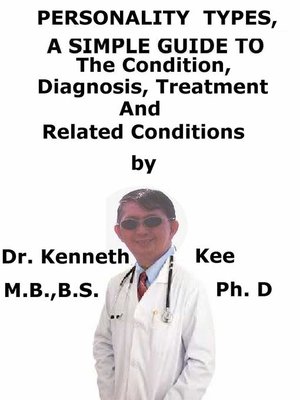Personality Types, a Simple Guide to the Condition, Diagnosis, Treatment and Related Conditions
ebook
By Kenneth Kee

Sign up to save your library
With an OverDrive account, you can save your favorite libraries for at-a-glance information about availability. Find out more about OverDrive accounts.
Find this title in Libby, the library reading app by OverDrive.



Search for a digital library with this title
Title found at these libraries:
| Library Name | Distance |
|---|---|
| Loading... |
This book describes Personality Types, Diagnosis and Treatment and Related Diseases
"In the end, it's the actions, how the person respond to circumstance, that reveals the character."
-Cate Blanchett
Personality typing is a system of classifying people based on their tendencies to think and function in particular ways.
Personality typing tries to find the widest, most important methods in which people are different, and make sense of these differences by classifying people into meaningful groups.
There are two ways to identify any personality type:
1. Are they better at facts & data or relationships?
2. Are they introverted or extroverted?
The personality types depicted here were constructed by Isabel Briggs Myers and her mother, Katharine Briggs, in the 1960's.
Their works were based on the theory of psychologist Carl Jung, even though they extended his ideas to create a more comprehensive framework of personality typing.
Myers and Briggs indicated that there were 4 key dimensions that could be used to classify people:
1. Introversion vs. Extroversion
2. Sensing vs. Intuition
3. Thinking vs. Feeling
4. Judging vs. Perceiving
Each of the 4 dimensions was depicted as a dichotomy, and either or choice between 2 styles of being.
Myers and Briggs believed that the preferences on each of the 4 dimensions would join to generate predictable patterns in belief and behavior so that people with the same 4 preferences would share many common traits:
1. In the way they approach their lives,
2. From the hobbies they choose
3. To the work that might suit them.
Each of the 4 letters in a personality type code refers to a preference in the person's style of thinking or behaving.
I/E: Introversion or Extroversion
The Introversion/Extroversion dimension expresses how a person organizes their energy.
Introverts are energized by expending quiet time alone or with a small group.
Extroverts are energized by expending time with people and in busy, active environments.
S/N: Sensing or iNtuition
The Sensing/Intuition dimension expresses how a person processes information.
Sensors direct on the person's five senses and is interested in information the person can directly see, hear, feel.
They are likely to be hands-on learners and are often depicted as "practical."
Intuitives direct on a more abstract level of thinking; the person is more interested in theories, patterns, and explanations.
The person often shows more concern with the future than the present and is often depicted as "creative."
T/F: Thinking or Feeling
The Thinking/Feeling dimension expresses how people make decisions.
Thinkers are likely to make decisions with their heads; they are fascinated in determining the most logical, reasonable choice.
Feelers are likely to decide with their hearts; they are worried on how a decision will affect people, and whether that fits in with their values.
J/P: Judging or Perceiving
The Judging/Perceiving dimension expresses how people approach structure in their lives.
Judgers value structure and order; they prefer things well planned, and dislike last-minute changes.
Perceivers value flexibility and spontaneity; they prefer to leave things open so they can change their minds.
The history of personality psychology goes as far back as Ancient Greece.
With the greater understanding of the psyche of man, the psychologists together with heart specialists have created type A, B, C, and D personalities.
The most popular to date is the Myers-Briggs Type...







